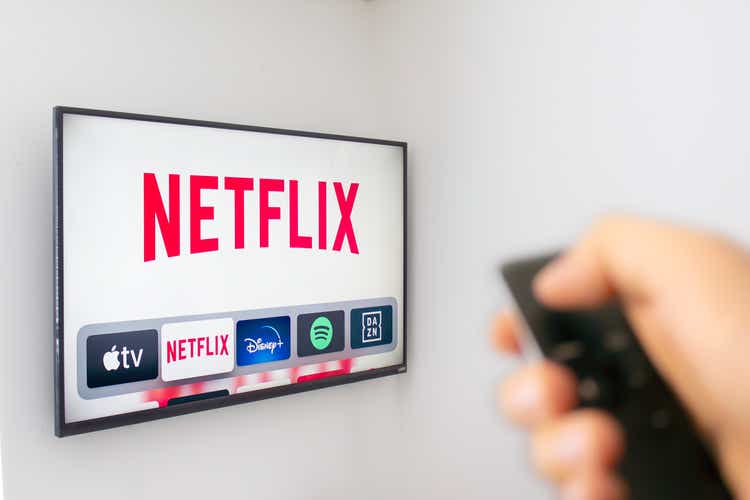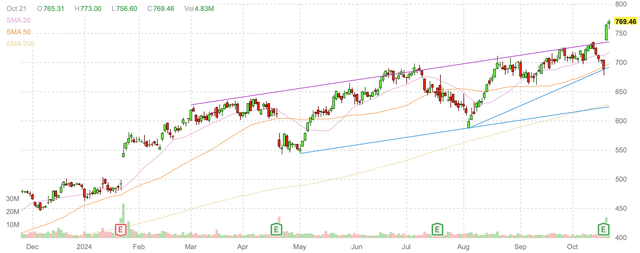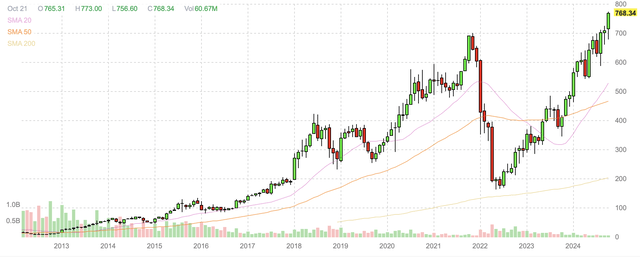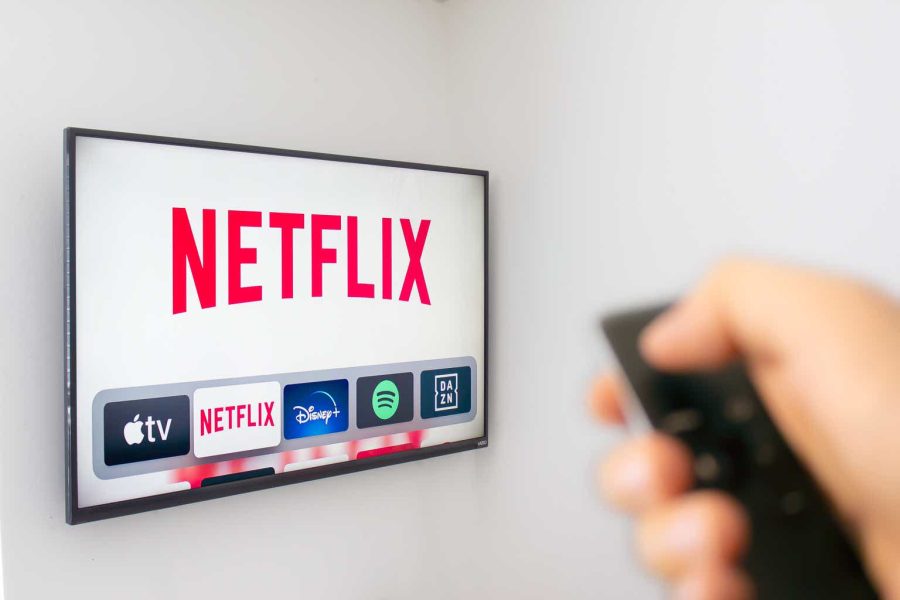Summary:
- Netflix’s Q3 2024 earnings exceeded expectations, with 15% revenue growth and strong operating margins, driving shares to new all-time highs.
- The ad-supported tier is gaining traction, boosting subscriber growth and advertising revenue, with potential for increased ad pricing and subscription fees.
- Netflix’s strategic investments in AI, live-streaming, and content are expected to enhance engagement, profitability, and international growth in 2025 and 2026.
- Shares are projected to reach $800+ by year-end 2024, with EPS estimates raised to $19.75-$20.00 for 2024 and $23.50-$24.00 for 2025.
Marvin Samuel Tolentino Pineda
Netflix (NASDAQ:NFLX) just broke out to new all-time highs, and it appears that shares may continue to ascend the chart on the strength of the company’s subscriber and profit growth. Further, Netflix has proven that its ad supported plan is a desirable destination for advertisers, and this recent revenue source is likely to grow due to increased subscriptions of the ad-supported tier, as well as Netflix’s capacity to increase advertisement pricing.
Netflix recently reported Q3 2024 earnings that were better than guidance and what Wall Street expected. Netflix reported that its revenue grew by 15 percent year over year to $9.82 billion in the third quarter, which beat by about $50 million. Notably, Netflix GAAP earnings per share were $5.40, which beat expectations by about $0.28. Netflix reported that its operating margins were 29.6 percent in the third quarter of 2024 and commented that “For 2024, we expect revenue growth of 15% (the high end of our 14% to 15% range), and operating margin of 27% (vs 26% previously).”
Netflix also reported that during the third quarter, it added 5.07 million net subscribers, bringing the company to 282.72 million total subscribers. Netflix’s revenue grew substantially, with approximately 16 percent year-over-year growth in the United States, Canada, and the EMEA region. Monthly average revenue per user (“ARPU”) for subscribers in the United States and Canada came in at $17.06, compared to $16.29 a year ago. Netflix noted that subscribers to the ad-supported tier were “up 35% quarter on quarter, and our ad tech platform is on track to launch in Canada in Q4 and more broadly in 2025.”
Netflix reported having free cash flow of $2.194 billion in the third quarter, compared to $1.581 billion in Q3 of 2023 and $1.213 billion in Q2 of 2024. Last quarter, free cash flow came in below guidance due to higher than forecast spending on new content and platform improvements. Given the strength seen in the third quarter, it is likely that we will see a higher spend on content and continued platform improvements in the fourth quarter. Much of the platform improvements spending is likely to be related to its capacity to deliver advertising, including the international expansion of the ad-supported tier, and technology designed to offer advertisers with more precise demographics and data on subscriber households.
Netflix’s report also “forecast 15% revenue growth, or 17% on a F/X neutral basis. We expect paid net additions to be higher in Q4 than in Q3’24 due to normal seasonality and a strong content slate. We project Q4 operating margin of 22%, a five percentage point year-over-year improvement.” For 2025 Netflix now forecasts revenue of $43 billion to $44 billion, which would represent growth of 11%-13% from its prior 2024 revenue guidance of $38.9 billion. Netflix also indicated it is targeting a 2025 operating margin of 28 percent, as compared to its prior forecast for 27 percent in 2024, but also commented that “We still see plenty of room to increase our margins over the long term.”
I believe Netflix has been making highly sensible capital investments that are likely to drive increased revenue and profitability in 2025 and 2026. In particular, Netflix should show significant growth in its advertising revenue, as this plan is likely to become its most popular global tier, and also a strong driver of Netflix’s international subscriber growth. Moreover, Netflix should be able to increase the pricing of its ad-free subscriptions, as well as increase the cost of advertising on the tier.
Prior to Netflix’s Q3 2024 reporting, I expected Netflix to have total 2024 earnings per share of about $19.25 and for 2025 EPS to be above $22.50. After reporting these strong third quarter results, I now expect Netflix’s full year 2024 EPS to come in at between $19.75 and $20 per share, and for its 2025 EPS to come in at about $23.50 to $24. This $0.50-$0.75 increase for 2024 and $1.00-$1.50 increase for 2025 is based on Netflix’s capacity to grow advertising revenue and maintain stronger than expected operating margins. There also is the possibility that Netflix will push through price increases on some of its subscription plans, and this could also be a source of revenue and margin strength that could result in better-than-expected earnings.
Netflix is also expanding into live-streaming of sports events, as well as other forms of live entertainment. Sports should improve engagement and provide the platform with potentially higher advertising fees due. Netflix has refrained from competing for the high-priced league sports programming that remains a cornerstone for many of its competitors. Instead, Netflix appears to prefer exclusive content and spectacle events, such as the boxing match between Mike Tyson and Jake Paul.
Jake Paul vs. Mike Tyson (Netflix.com)
Netflix should also be increasingly recognized as a beneficiary of artificial intelligence, as the company is one of few market participants that is already improving its products due to its AI related capital expenditures. Netflix is well known for its use of proprietary technology to push recommendations to its subscribers, as well as to determine what new content it should purchase or develop. Netflix also has one of the better content personalization capacities that it uses to suggest both new and existing content from within its catalog. Netflix appears likely to use AI optimization to improve its capacity to promote demand for older content. Such tailoring may result in increased engagement and higher margins due to greater utilization of pre-existing content.
Following the reporting of its Q3 2024 earnings, Netflix broke out of a wide and slightly ascending trading range. The move was significant, taking shares from essentially the middle of the trading range in which shares were stuck for all of 2024 to pricing at least five percent a above where upside resistance likely sat.
Netflix daily candlestick chart (Finviz.com)
It now appears as though the top of that trading range is now support for a move higher from here. I actually question wherever Netflix is likely to test that support, absent a broad market downturn that takes all equities down with it. Rather, I think it is now likely that shares continue to move higher, and essentially into the $800s before the end of 2024.
Prior to this recent break out that is making new all-time highs, Netflix last peaked in late 2021 at prices comparable to current levels, only to later fall by approximately seventy percent. Since mid-2022, shares have been in a reasonably strong uptrend, but that move only retraced that which occurred between 2019 and 2021.
Netflix monthly candlestick chart (Finviz.com)
Now that Netflix has breached this prior resistance and done so after basing in a reasonably tight trading range for most of 2024, shares appear primed to move considerably higher in the coming quarters. This is at least partially because it is now likely that all would-be sellers of shares have been exhausted and already exited the stock, and that the remaining shareholding base is not likely to flip out of shares on the next move higher. But more importantly, Netflix has now proven that it is capable of adding an ad-supported tier while maintaining its pre-existing ad-free subscription tiers, and is even capable of increasing subscription fees and advertising pricing due to the strong value proposition its products offer to subscribers and advertisers.
Risks
Netflix’s U.S. business is fairly mature and unlikely to substantially increase. Instead of growing the domestic subscriber base, Netflix may find its existing subscribers switch from ad-free plans to the ad-supported tier. This may be less profitable, but it may actually be more profitable, depending upon advertising prices. Nonetheless, the market prefers subscription-based revenue because it is more consistent and allows for highly predictable rates of monthly cash flow. It is also possible that even if Netflix can optimize the ad-supported tier to be its highest margin plan, that the upfront costs associated with getting the technology in place will reduce near term margins and earnings per share.
While Netflix appears capable of increasing in value due to the significant drawdown that occurred in 2021 into 2022, and it only recently breaking out to new highs, Netflix is far from a deeply undervalued equity. Netflix also has multiple metrics that can disappoint, including subscriber growth, margins, free cash flow, and ARPU. Netflix’s primary expense is spending on new content, both in the form of acquiring it from others or developing it from scratch. New content is speculative, and even though Netflix has done a good job of buying and creating content in the past, this does not guarantee reflex will have similar success in the future.
Another key concern to Netflix reaching its targets could be a strengthening dollar, as it would lower the contribution to international growth. This could be a meaningful headwind, since most of Netflix’s growth should come from international markets, but it could also be a tailwind if the dollar weakens along with forthcoming interest rate cuts.
Conclusion
Netflix is the leading streaming service, and its size and scale are not fully appreciated by the market. Further, Netflix’s addition of ad-supported plans is likely to continue to surpass expectations in 2025 and 2026, as the platform proves itself as an above-average deliverer of advertising and a preferred destination for new ad campaigns.
Netflix shares were in a wide, ascending trading range for most of 2024, but broke out of that range after reporting strong earnings earlier this October. The strength and scale of the break-out indicate a high probability that shares continue to move higher in the near term, and potentially well into the $800s before the end of 2024. I now expect Netflix to have total 2024 earnings per share of about $19.75-$20.00, up from a prior target of $19.25. Further, I now expect it to earn between $23.50 and $24.00 in 2025, and that shares should trade well above $800 as similar targets proliferate Wall Street analyst targets and expectations.
I continue to base proper Netflix price targeting on a 35x forward price to earnings multiple, which is high for the market, but not for Netflix’s growth, free cash flow, and profit margins (35x $23.50-$24.00 = a target range of $822.50 to $840). Shares could easily surpass this target on the reporting of another strong quarter of subscriber growth and/or advertising revenue strength.
Analyst’s Disclosure: I/we have a beneficial long position in the shares of NFLX either through stock ownership, options, or other derivatives. I wrote this article myself, and it expresses my own opinions. I am not receiving compensation for it (other than from Seeking Alpha). I have no business relationship with any company whose stock is mentioned in this article.
Seeking Alpha’s Disclosure: Past performance is no guarantee of future results. No recommendation or advice is being given as to whether any investment is suitable for a particular investor. Any views or opinions expressed above may not reflect those of Seeking Alpha as a whole. Seeking Alpha is not a licensed securities dealer, broker or US investment adviser or investment bank. Our analysts are third party authors that include both professional investors and individual investors who may not be licensed or certified by any institute or regulatory body.
